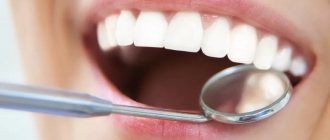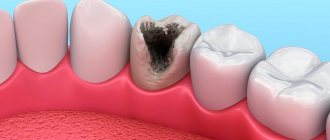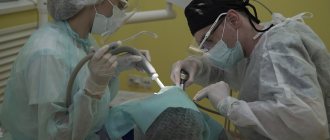What is a dry socket after tooth extraction?
Dry socket syndrome (alveolitis) is the definition of a disorder when a blood clot does not form after tooth extraction.
This is dangerous because it is accompanied by bleeding and the risk of infection. Complications are possible for two reasons: when a clot does not form at all, and when it falls out after a while.
What does it look like?
The socket may be partially or completely filled with food particles and necrotic tissue from the disintegration of a blood clot
Upon visual inspection, the alveolitis looks like an empty hole.
It may be partially or completely filled with food particles and necrotic tissue from the breakdown of a blood clot.
When touched, pain is felt, especially if the alveolar bone is exposed.
Often the edges of the hole converge so that its contents cannot be seen. When washed, a cloudy liquid with food residues comes out of it.
What does it mean?
Alveolitis occurs in 4-5% of cases, and after removal of wisdom teeth in 25-30%. Such a violation indicates either a doctor’s error, or systemic diseases, or non-compliance with the rules for caring for the hole after extraction.
The destruction of the clot (fibrinolysis) is caused by a high concentration of estrogen and toxins released by bacteria in the presence of carious cavities.
What should be normal?
After tooth extraction, a blood clot forms within 2-3 hours. It prevents bleeding and protects tissues from infection.
It gradually dissolves. On day 3, granulation begins, followed by the growth of new epithelium. After a week, bone tissue begins to form. After a few months it calcifies, and then complete recovery occurs.
Clinical diagnosis
Externally, the hole looks like a deep hole in the gum that has an unhealthy color. You can diagnose this disease yourself using the above symptoms, but visiting a doctor in this case is mandatory.
If severe pain, general weakness, redness of the gums and high fever appear in the socket area, you should suspect the development of alveolitis.
The dentist most often makes a diagnosis based on external signs. Visually, he is able to determine the degree of damage to the hole, on the basis of which the treatment method is selected. Additional blood tests may be required to confirm the diagnosis.
Based on the results obtained, the specialist prescribes appropriate medications to the patient.
The process of diagnosing a disease begins with an examination of the dentist and a survey of the patient. Already at the first pathological manifestations, you need to consult a doctor, because when the disorder starts, irreversible purulent-necrotic processes can arise and actively progress.
Immediately after removal, several preventive visits to the doctor are required. Usually, to identify alveolitis, it is enough to ask the patient about complaints and visualization; less often, radiography, computed tomography, and electromyography are additionally performed. When a disease occurs, the doctor detects a plaque with a green or yellow tint in the oral cavity.
Differential examination is not difficult, since the clinical picture of alveolitis is specific. It is important to distinguish it only from alveolar neuritis. But with neuritis, the temperature does not rise, the lymph nodes remain normal, there is no inflammation. Therapy proceeds faster, and the pathology itself is not dangerous if proper, timely assistance is provided.
Symptoms
Manifestations of a dry socket after tooth extraction:
- With alveolitis, the gums are inflamed, the socket is red, and exposed bone is visible at the bottom
2 days after extraction, gum inflammation occurs and pain increases;
- an unpleasant smell and taste appears;
- pain spreads to the neck area;
- Reversible hearing loss may occur.
With alveolitis, the gums are inflamed, the socket is red, and exposed bone is visible at the bottom. Pus may be released when pressure is applied.
Why is pathology dangerous?
If you do not pay close attention to the problem, then within a few days after the operation severe pain will begin, indicating inflammation of the socket of the extracted tooth, that is, alveolitis. The disease is dangerous because, if treated improperly and not seeing a doctor in a timely manner, it can lead to the development of gumboil, when the cheek swells and an abscess appears on the gum. But flux is not the worst thing. Advanced alveolitis can lead to a purulent abscess, phlegmon of the soft tissues of the face and osteomyelitis of the jaw, damage to internal organs, sepsis (blood poisoning), and death.
Causes
Causes of dry socket may include:
- blood clotting disorder;
- incorrectly selected anesthesia;
- severe tissue injury during extraction;
- active rinsing of the mouth in the first days;
- smoking immediately after the procedure;
- a tooth fragment remaining in the socket;
- poor tissue washing, which leads to infection.
Important! If at the time of tooth extraction there are foci of infection in the oral cavity, this will become a factor of alveolitis. Before extraction, professional hygiene must be carried out and inflammatory processes are eliminated.
How to remove a tooth
There are two extraction methods used in dentistry: simple and complex. Their choice depends on which teeth are being removed - premolars and molars with tangled branched roots are removed using a complex method. It is very difficult to pull out such elements entirely due to the fact that the tooth socket is penetrated by retaining ligaments and alveolar processes. Errors during the procedure or insufficient experience of the specialist lead to serious complications. Therefore, even despite the acute condition, always find out in advance where you can have a tooth removed from a good doctor with positive recommendations.
Factors complicating the operation:
- complete destruction of the coronal part;
- high fragility;
- acute inflammatory diseases;
- Unerupted or misaligned wisdom teeth.
The technology of the procedure depends on which teeth are removed. In some cases, tissue incision and suturing are performed.
Possible forms
The table shows the forms of alveolitis:
| Form | Features of the flow |
| Acute inflammatory process | Pain, swelling of the gums, no discharge, body temperature is normal |
| Chronic inflammatory process | Granulations are present, the pain is mild, droplets of pus may be released, the general condition is unsatisfactory, there is weakness, malaise |
| Purulent-necrotic inflammatory process | There is a sharp pain radiating into the ear, a strong increase in body temperature, swelling of the gums, a dark coating is revealed at the bottom of the socket, pus is released when pressed, and there is a persistent bad breath. The most complex form, often requiring surgery |
Wound healing time after surgery
Patients who have developed a protective clot may already notice on days 5-7 after surgery that the wound has almost completely healed, and new epithelial and granulation tissue is forming at the site of the clot. From about the second week of the operation, bone tissue restoration begins, which lasts for the next several months. People who have a “dry” socket experience that the wound heals several times more slowly.
How long does it take for a dry socket to heal? This usually takes up to 14 days, but only on condition that the patient’s condition is under control, that is, he was provided with timely medical assistance. If a pathological inflammatory process has developed, then the wound can take a very, very long time to heal, and the pain will continue to bother you for 10-40 days.
Important! The rate of tissue healing can be influenced by the patient’s age, immune status, and the number of roots of the extracted tooth. Thus, in elderly people, regeneration processes last on average 7 days longer than in young people. A wound left after a multi-rooted tooth heals in 10-16 days, and after a single-rooted one – 7 days.
Associated symptoms
Dry socket may be accompanied by symptoms such as:
- High temperature accompanies acute and purulent inflammation, a dangerous symptom that requires immediate attention from a dentist.
- Swelling of the cheek indicates the accumulation of pus, the development of a dangerous purulent form of the disease.
- Severe pain is an obligatory companion of alveolitis and increases with exposure of the bone and purulent inflammation.
Treatment
Treatment methods will depend on the severity of alveolitis:
- Light - rinsing with antiseptics and anti-inflammatory agents.
- Medium - taking antibacterial agents, filling the hole with medicine.
- Severe - hospitalization, therapy, depending on complications, recovery includes physiotherapy, ultraviolet irradiation.
Important! Antiseptic rinses and antibiotics only temporarily eliminate the symptoms of inflammation, so curettage (cleaning the socket) will be the only effective method of treatment.
Treatment at home
Treatment at home is carried out for mild inflammation
Treatment at home is carried out for mild inflammation.
For this purpose, the drugs Chlorhexidine, Miramistin, and potassium permanganate solution are used.
The mouth is rinsed with the products after each meal.
Additionally, you can use decoctions of chamomile, sage, calendula, and oak bark.
The doctor may prescribe Solcoseryl dental paste. It has an analgesic effect and promotes the healing of damaged tissue.
It is introduced into a hole pre-washed with an antiseptic. The paste gradually dissolves, so there is no need to remove it. Periodically it needs to be added to the hole.
Dental care
Stages of dry socket treatment at the dentist:
- Anesthesia.
- Removing food particles and necrosis from the hole.
- Washing with an antiseptic.
- Drying and filling the hole with iodoform turunda.
Important! Without removing the necrosis, any other therapeutic measures will be useless.
After curettage, the dentist prescribes medications and gives recommendations on how to care for the hole. The medicine in the hole needs to be changed every 3-5 days. You will have to visit the dentist at least 3 times.
Treatment by creating a secondary clot
When the cavity fills with blood, the dentist applies an anti-inflammatory agent and places several stitches
Treatment by creating a secondary clot involves curettage of the socket to provoke bleeding.
When the cavity fills with blood, the dentist applies an anti-inflammatory agent and places several stitches. After the procedure, you need to take antibacterial drugs.
This method of treatment is possible only in 2 cases: when the patient seeks help immediately after a clot has fallen out, and in case of indolent alveolitis without pronounced symptoms, provided that the hole is filled with granulation.
Medication assistance
After cleaning the hole, the following medications are prescribed:
- painkillers based on NSAIDs - Ibuprofen, Nise, Diclofenac;
- antibiotics - Amoxiclav, Lincomycin, Unidox-solutab;
- Chlorhexidine solution 0.05% for rinsing.
What to do to prevent alveolitis
Alveolitis most often develops after the removal of third molars - wisdom teeth. This is due to the high traumatic nature of the doctor’s manipulations. Often, additional cutting is required, peeling off the gums, sawing the tooth into several parts to make it easier to remove it if the roots are bent.
After 30 years, alveolitis in the current situation occurs several times more often, since the jaw itself becomes denser, not enough blood flows into it, and the socket often remains dry.
After the removal of third molars, the doctor may recommend the implementation of prophylaxis. The main goal is to prevent complications. To do this, you need to strictly follow all the dentist’s advice so that the blood clot in the socket is preserved and healing proceeds as it should.
What to do for prevention:
- avoid intensive rinsing;
- avoid foods that are too hot, because heat provokes inflammation;
- do not chew on the operated side;
- do not touch the wound with your hands;
- do not pick the hole with improvised objects;
- do not try to remove the blood clot;
- organize proper care.
The patient should visit the dentist twice a year for preventive examinations.
When performing an operation, the doctor observes the following precautions:
- proper treatment of the patient’s hands, instruments, and mouth;
- carrying out the operation in accordance with the regulations and stages;
- after removal, the edges of the hole must be connected so that it fills with blood;
- placing a hemostatic sponge in the socket to prevent alveolitis and stop bleeding;
- suturing in cases of severe soft tissue injury.
The most common complication after tooth extraction is dry socket. You should know why this disorder occurs and what to do when symptoms appear.
Dry socket syndrome (alveolitis) is the definition of a disorder when a blood clot does not form after tooth extraction.
This is dangerous because it is accompanied by bleeding and the risk of infection. Complications are possible for two reasons: when a clot does not form at all, and when it falls out after a while.
General rules for caring for the tooth socket after surgery
It is important to pay attention to oral care in order to avoid infection. Thanks to antiseptics (Chlorhexidine or Furacilin), unsanitary conditions and inflammatory complications can be avoided. In order to use antiseptic solutions, you should know that use is prescribed after 24 hours from the date of tooth amputation.
The rinsing is gentle, so as not to wash the protective layer in the hole. After a few days, the antiseptic can be replaced with folk remedies: herbal infusions, soda or salt solutions, strong tea. The solution should be of such a consistency that it does not cause additional drying or damage to the oral mucosa. Don't overuse antibiotics. They should be prescribed by the attending physician only in case of severe symptoms in the form of inflammation or suppuration.
List of other means and methods for care and treatment of the affected area in case of complications:
- rehabilitation, i.e. medical therapy to remove pus, dead tissue and tooth fragments from the socket;
- drainage procedures (installation of a drainage tube to drain purulent deposits);
- suturing.
What should everyone know after tooth amputation?
Here are the rules that must be followed. Abuse of bad habits or an indifferent attitude towards such wounds can turn out very badly and affect the health of not only the oral cavity, but the entire body as a whole. What rules do you need to know?
Wait 2-3 hours after tooth extraction and do not take any food or water.
- Find the strength to hold the gauze under pressure for 20 minutes, which the doctor left in the wound after the amputation of the tooth.
- Ban yourself from visiting steam rooms and swimming pools; you will be forced to give up even sports and active recreation.
- Consuming alcohol, tobacco products, as well as eating hard, hot, spicy or sour foods will have an extremely negative impact. This can irritate or dry out the oral mucosa, increasing pain and increasing the risk of developing inflammation or infectious diseases.
- Protect the affected area of the mouth from damage and temperature changes, and try not to sleep on that side.
- Remember the most important thing: a blood clot formed in the socket of an extracted tooth performs protective and antiseptic functions. Removing it will lead to the wound opening and suppuration.
- Do not drink liquid from a straw. This will also help remove the blood clot.
- Try to protect the affected part of the jaw from damage by chewing food only in the untouched area.
- On the first day after tooth amputation, refrain from brushing your teeth. In the following days, it is advisable to brush your teeth twice a day, paying special attention to the affected areas of the gums.
- Your immunity will be weakened, try to avoid contact with sick people, as well as visiting cool places.
wisdom tooth
Thus, your health and consequences after tooth extraction directly depend on your attitude to care and proper treatment. Don’t be afraid to visit your doctor often and in a timely manner; this can protect you from serious illnesses and serious consequences. If you find that:
- bleeding does not stop after amputation;
- unbearable pain is felt for several days;
- 4 or more days body temperature is above average;
- noticeable inflammation forms, the formation of a malignant odor from the oral cavity - do not hesitate. You urgently need a doctor’s consultation, and perhaps the right course of treatment!
Prevention at home
After the operation, certain rules should be followed that will significantly reduce the chance of alveolitis occurring:
- do not rinse your mouth on the day of the operation;
- eliminate smoking;
- Avoid eating hot and spicy foods , as well as foods that require effort to chew;
- do not touch the hole even with your tongue>;
- exclude physical activity and visiting the sauna.
Treatment of severe dry socket
Symptomatic drugs are used to reduce temperature, relieve pain, relieve swelling
Severe forms of the disease require hospitalization. The patient is prescribed a number of measures, depending on the manifestations.
Treatment will be aimed at eliminating complications - abscess, phlegmon, cysts.
Physiotherapy is prescribed - electrophoresis, UHF, ultraviolet radiation. Patients are kept on bed rest.
Symptomatic remedies are used to lower the temperature, relieve pain, and relieve swelling.
For fibrosing alveolitis, glucocorticoid drugs are prescribed. If they are ineffective, the doctor prescribes immunosuppressants and Penicillamine. Without treatment, rapid replacement of epithelial tissue can lead to respiratory failure.
For toxic and allergic inflammation, glucocorticoids are also indicated. To speed up recovery, the doctor recommends special breathing exercises, physical exercise, and taking vitamin complexes.
Pathology prevention measures
Every patient can protect himself from the occurrence of an unpleasant problem. To do this, you must initially choose professional dental surgeons who specialize in surgical interventions. At the stage of planning the operation, you need to inform the specialist about the diseases you have and the medications you are taking, so that the doctor, based on the data received, can draw up an individual treatment plan.
At home, you need to follow all the recommendations of specialists without exception. It is especially important to follow those that prevent damage and dissolution of the protective clot. Namely: you need to stop eating hot and solid foods, you shouldn’t engage in sports or physical activity, and you shouldn’t touch the wound with any objects or hands. For a while, you should stop smoking and drinking alcohol, as well as actions that lead to overheating, a rush of blood to the head and severe swelling of the tissues.
Preventive measures
To prevent alveolitis, follow these recommendations after tooth extraction:
- For the first 3 days, do not rinse your mouth, but lightly rinse the hole with decoctions and prescribed antiseptics, putting them in your mouth for 10-20 seconds;
- After each meal, inspect the hole so that food does not get stuck in it; if necessary, rinse it, but with extreme caution;
- do not apply anything hot to your cheek and gum; heating the socket is strictly prohibited;
- stop smoking and alcohol until complete healing;
- do not self-medicate, and take only those medications prescribed by your doctor, and be sure to coordinate traditional medicine recipes with him;
- If pain and other symptoms do not go away within 3-5 days, contact your dentist.
Medical procedures
If the “dry” socket is not inflamed, then the doctor will prescribe a list of medications, the main purpose of which is to prevent the inflammatory process, disinfect the operated tissues and speed up their healing. To achieve the desired effect, antiseptics and anti-inflammatory drugs are usually prescribed. Sutures may be placed on the wound as a protective measure.
On a note! If you consult a doctor as soon as possible after washing the clot out of the wound, the specialist can use this method of treatment: using a curettage spoon, the doctor stimulates re-bleeding. After filling the hole with blood, the specialist puts the medicine inside, brings the edges of the wound together and applies stitches. All manipulations are performed under anesthesia. Interestingly, in some dentistry, specialized vacuum devices are used to fill the socket with blood[1].
In case of alveolitis and tissue inflammation, the dentist performs curettage (cleaning or scraping), removes granulations and fragments of the extracted tooth from the wound, rinses it from pus and food debris, and puts antibacterial, antiseptic and regenerating agents inside. If necessary, stitches may be applied. The patient is sent home with a list of medications that must be used for prevention and against the recurrence of complications - these are antibiotics, drugs to relieve symptomatic manifestations (painkillers, antipyretics, antihistamines), antiseptics, vitamins.
If the process is too advanced, for example, the patient has developed osteomyelitis, then hospitalization is necessary. The patient is required to strictly adhere to bed rest and follow all recommendations of specialists. Treatment combines surgical, medicinal and physiotherapeutic methods. Then the patient undergoes a long period of rehabilitation.











